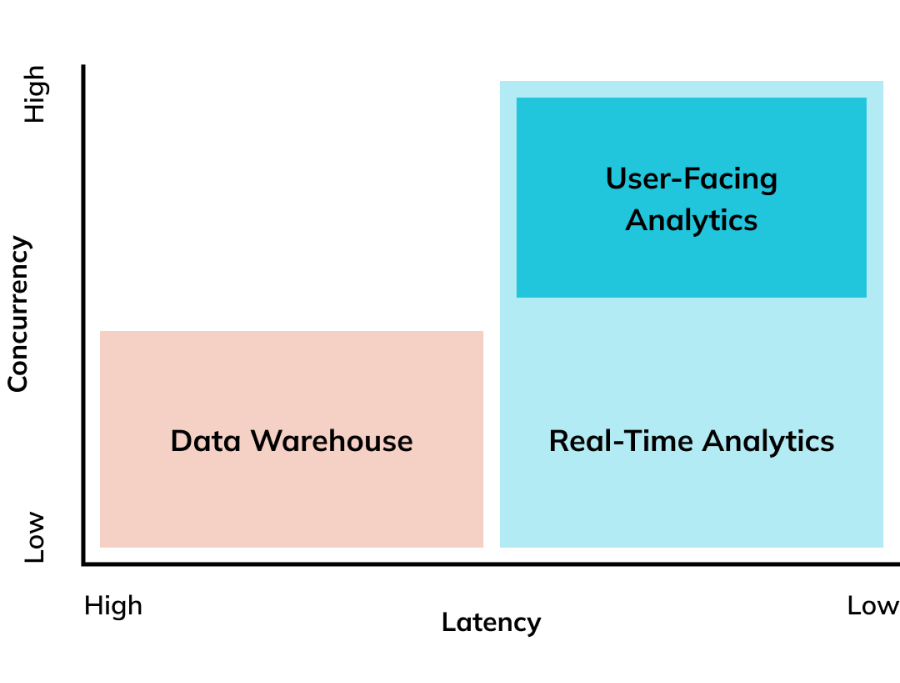What is User-Facing Analytics?
Introduction to User-Facing Analytics
User-facing analytics provide insights to end-users of systems, as opposed to internal organizational stakeholders. Because of this, user-facing analytics systems need to support far larger numbers of concurrent queries and provide answers through real-time dashboards, as well as desktop and mobile applications.
User-facing analytics are based on the premise that nearly everyone, from internal stakeholders to external users — from front consumers to line employees, to the C-suite — has some visibility into a system’s real-time data given the constraints of access controls, data governance and security, of course.
As the volume of data generated and amassed by companies continues to grow, the nuances of the data analytics field multiplies. User-facing analytics is a new frontier focused on quickly delivering analytics to thousands of end users concurrently. This article discusses the value of user-facing analytics and offers a comparison between user-facing analytics and real-time analytics. Additionally, we explore the challenges that companies are addressing through the adoption of user-facing analytics.
From Traditional BI to Democratized Decision-Making
It used to be that only a select few people in an organization could see or utilize an organization’s data. This was often due to computational limits — too many reports run simultaneously would drive load on servers unacceptably high, thus those with the greatest organizational control would reserve rare and expensive computing resources for reporting. This was the case for data warehouses.
With the increasing power and scalability of modern cloud computing organizations can finally deliver user-facing analytics, fully harnessing the data they have at their disposal — democratizing it and everyone fully benefiting from the value of it.
What's the Difference Between User-Facing Analytics and Customer-Facing Analytics?
User-facing analytics and customer-facing analytics are typically used interchangeably. They refer to analytics that are served to external users such as customers or end users, as opposed to more traditional business analytics tools that deliver analytics to internal stakeholders.
Also note that users of a service may or may not strictly be commercial customers. For example, people may freely use social networks, websites or mobile apps, yet still desire real-time insights.
Are User-Facing Analytics the Same as Real-Time Analytics?
User-facing analytics are real-time analytics systems capable of supporting high concurrency and massive data scale. Not all real-time analytics systems are capable of user-facing analytics. Some real-time analytics systems may be limited in scale — bound by hard constraints of memory or processing power — therefore incapable of supporting massive concurrency.

Other systems capable of massively concurrent processing — for instance, a data warehouse — may not provide real-time results, or its results may not be based on the most recent data — an attribute known as data freshness.
Check out our article on real-time analytics and real-time analytics databases to learn more.
User-Facing Analytics in Action
Social Media — LinkedIn required analytics for each of their hundreds of millions of users, to show who viewed a user’s profile. They invented a real-time analytics database to support this function, which eventually became open sourced as Apache Pinot.
Food Delivery — Uber Eats brings together consumers and their favorite food venues in real-time. All parties involved want to track the status of orders, and brands overall want to monitor customer satisfaction, sales, service quality, and even the rate of abandoned orders. Uber Eats implemented Apache Pinot to track the status of their food delivery network in real time. You can read more about the Uber Eats Restaurant Manager.
Payment Systems — Stripe processes payments in real-time at petabyte scale. They use both real-time event streaming — Apache Kafka — with real-time analytics — Apache Pinot — to track funds for their large user base.
Learn more about how companies are using user-facing analytics.
What Is a User-Facing Analytics Database?
User-facing analytics databases are designed to handle hundreds of thousands or millions of queries per second. User-facing analytics are a subset of the domain of real-time analytics that provide massively concurrent query support.
User-facing analytics databases, like Online Analytical Processing (OLAP) databases in general, require special kinds of data structures, indexing and storage make data quickly findable, such as through column store formats. They also require real-time data ingestion from data streaming systems, such as other real-time analytics databases. Yet user-facing analytics databases also require the decoupling of compute from storage so that they can scale out the amount of queries they can process separately from growing the size of data under management.
User-Facing Analytics with Apache Pinot
Yes. Apache Pinot is capable of supporting extremely high concurrency queries in real-time, and was invented specifically for this purpose. Some other systems can support real-time queries, but only with limited concurrency. In other cases systems are capable of highly-concurrent queries, but without low-latency, real-time, fresh data responsiveness. Apache Pinot is rare in providing both high concurrency as well as real-time, low latency responsiveness needed for user-facing analytics.
Learn More About Apache Pinot
Does StarTree Cloud Support User-Facing Analytics?
Yes. StarTree Cloud, StarTree’s fully-managed Database-as-a-Service (DBaaS), is powered by Apache Pinot, so it supports user-facing analytics workloads. As well, StarTree Cloud has additional features, like the StarTree Data Manager, making it easy to model data and ingest it into StarTree Cloud from both real-time and batch data sources. StarTree Cloud also supports StarTree ThirdEye, which provides anomaly detection and root-cause analysis.
Learn more about StarTree Cloud